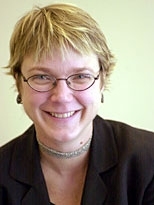Professor Linda Griffith, a noted biotechnologist, has won a 2006 MacArthur Fellowship, more commonly known as a "genius" grant. Griffith was honored for "shaping the frontiers of tissue engineering and synthetic regenerative technologies," according to the John D. and Catherine T. MacArthur Foundation.
This year, the foundation selected 25 MacArthur Fellows for their "creativity, originality and potential to make important contributions in the future," according to the MacArthur Foundation announcement.
Fellows receive $500,000 in "no strings attached" support over five years. Candidates for the fellowship are nominated, evaluated and selected through a confidential process; no one may apply for the awards and interviews are not conducted.
Griffith, 46, heard the news last week when she received a call from Daniel Socolow, director of the MacArthur Foundation.
"I was in with students and he called twice and left a message with his number but would not tell my assistant what it was about. His name also bears similarity to a law firm that advertises on late night TV around here, so I was very curious," Griffith said. " I called back and he started quizzing me on how many MacArthur Fellows I knew, and he kept saying he was sure I knew one more. I didn't get it until he told me."
Griffith called the fellowship "a huge surprise" and said it was coming at the perfect time in her career. "With all the activity of getting the new biological engineering S.B. off the ground the past couple of years, it has been hard to find the time to pursue new ideas," Griffith said. "This is such a terrific opportunity. I am elated."
According to the biography provided by the MacArthur Foundation, Griffith has "designed several methods for fabricating scaffolds on which cultured cells can adhere and grow."
She developed new polymers for controlling the physical presentation of cell adhesion molecules and growth factors that govern cell behaviors. Working with collaborators at MIT, she also developed new ways to make scaffolds for growth of bone tissue, precisely controlling the pore size and surface chemistry of three-dimensional substrates. Most recently her work has focused on creating microscale physiological models of liver using a combination of scaffold technology and fluid flow to induce organization and function of liver cells.
With these results, Griffith is developing a powerful tool for exploring the normal function of the liver and the mechanisms of disease that attack it, offering the prospect of significant reduction in the need for future organ replacement or regeneration.
"Her latest experiments are expanding the use of 3-D scaffolds for growing other cell types, such as blood-forming cells; as with the liver culture studies, these experiments lay the groundwork for building in vitro models of toxicity and cancer metastasis," according to the foundation.
According to the biography, Griffith is helping to create the new discipline of biological engineering and its applications for diagnosing disease and regenerating damaged tissues at the intersection of materials science, cell biology and physiology.
For Griffith, the fellowship is a reflection on the MIT culture as much as anything else. "Lots of people have creative ideas, but to be successful you need an environment that fosters creativity --and there is no place like MIT for that," Griffith said. "I was very lucky to be a junior faculty member here, with such terrific colleagues to help me get some early ideas going, and I feel lucky every day for the spirit of adventure that pervades MIT."
"I am also very grateful that MIT fostered creation of biological engineering -- now Course 20 -- having students who are educated as 'biological engineers' makes all the difference in my work and in the work of all my biological engineering colleagues," Griffith said.
Griffith received a B.ChE. (1982) from the Georgia Institute of Technology and a Ph.D. (1988) in chemical engineering from the University of California at Berkeley. In 1991, she joined the MIT faculty as an assistant professor of chemical engineering (1991-1996), after serving as a postdoctoral associate from 1988-1990. Her scientific articles have appeared in such journals as Science, Biomaterials, and Proceedings of the National Academy of Sciences.
A version of this article appeared in MIT Tech Talk on September 27, 2006 (download PDF).






